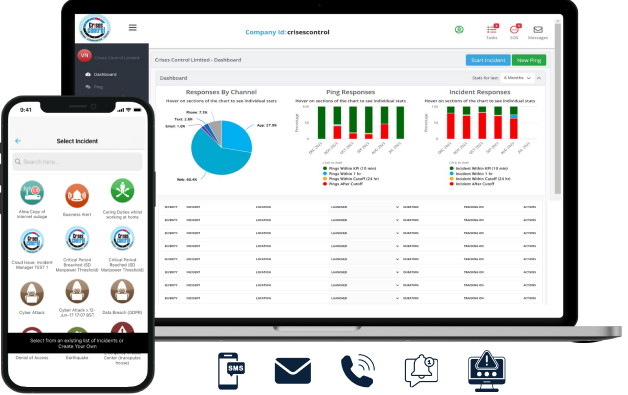Written by Anneri Fourie | Marketing Executive
Imagine this: chaos erupts in your workplace. A fire alarm blares, but some employees are working remotely or wearing noise-cancelling headphones. A chemical spill occurs, but vital safety protocols haven’t been effectively communicated. These scenarios highlight the critical role of emergency communication systems in crisis management.
An emergency communication system is the backbone of any organisation’s ability to respond effectively during emergencies. It ensures timely and accurate information reaches all stakeholders, enabling them to take appropriate actions and minimise risk. This comprehensive guide will equip you with the knowledge to select and implement the perfect system for your organisation.
The High Cost of Communication Silos
Before diving into solutions, let’s explore the problem an emergency communication system aims to solve: communication breakdowns.
Traditional methods like email and phone trees often fall short. Emails get buried in inboxes, and phone calls can go unanswered, especially during emergencies when people are stressed or on the move. These communication silos can put lives at risk and significantly hinder recovery efforts.
The Power of Mass Notification Systems: Reaching Everyone, Instantly

Mass notification systems, a core component of many crisis management solutions, bridge these communication gaps. They leverage a variety of channels to deliver critical information rapidly and reliably, ensuring everyone is informed – regardless of location or device.
Here’s a breakdown of some popular notification channels utilised by mass notification systems:
- Desktop Pop-Ups: Alerts appear directly on employee computer screens, bypassing distractions and demanding immediate attention.
- SMS Text Messages: With a 90% open rate within minutes, SMS ensures vital information reaches employees even if they’re not actively checking email.
- Voice Messages: Pre-recorded messages can be delivered to landlines and mobile phones, providing crucial audio instructions during emergencies.
- Mobile Push Notifications: Alerts sent directly to smartphones ensure employees receive critical information even when they’re away from their desks.
Beyond Emergency Response: The Multifaceted Benefits of Emergency Communication Systems
The value of an emergency communication system extends far beyond emergency response. Here are some additional benefits organisations can reap:
- Improved Business Continuity: Rapid communication during disruptions minimises downtime and facilitates a smoother recovery process.
- Enhanced Employee Safety: Clear and consistent communication empowers employees to make informed decisions during emergencies, safeguarding their well-being.
- Reduced Liability: A well-documented communication plan demonstrates an organisation’s commitment to employee safety, potentially mitigating legal repercussions.
- Streamlined Daily Operations: Mass notification systems can be used for non-emergency purposes as well, such as disseminating company announcements or weather alerts.
Choosing the Right Emergency Communication System: Factors to Consider
With a plethora of emergency communication options available, selecting the right fit for your organisation requires careful consideration. Here are some key factors to ponder:
- Organisational Size and Structure: A large, geographically dispersed organisation will require a more robust system with wider notification channel options compared to a smaller, localised company.
- Types of Emergencies: Identify the emergencies your organisation is most susceptible to (e.g., fire, natural disasters, security threats). Choose a system with functionalities tailored to address these specific scenarios.
- Scalability: Consider future growth and ensure the system can accommodate an expanding workforce or additional locations.
- Ease of Use: An intuitive user interface is crucial for administrators to send alerts quickly and efficiently during emergencies.
- Integration Capabilities: Seamless integration with existing security systems or building management software can streamline emergency response workflows.
- Cost: Communication solutions range in price depending on features and user capacity. Determine your budget and prioritise features that align with your organisation’s specific needs.
Implementing Your Emergency Communication System: A Step-by-Step Guide

Once you’ve chosen your solution, successful implementation is paramount. Here’s a step-by-step breakdown:
1. System Configuration:
Work with your vendor to configure the system according to your organisation’s needs. This includes setting up user roles, notification channels, and emergency protocols.
2. Employee Training:
Educate employees on the system’s functionalities and how to respond to different types of emergencies communicated through the system.
3. Regular Testing:
Conduct regular drills and tests to ensure the system functions flawlessly during an actual crisis.
4. Develop Clear Communication Protocols:
In the throes of an emergency, clear and concise communication is essential. Pre-plan and document communication protocols that outline:
- Who triggers alerts: Designate authorised personnel responsible for initiating emergency notifications.
- What information gets communicated: Establish a standard format for emergency messages, ensuring they include critical details like the nature of the emergency, evacuation instructions, assembly points, and updates.
- Communication cadence: Determine the frequency of updates based on the evolving situation.
- Multilingual communication: If your workforce is diverse, consider offering translated messages to ensure everyone understands critical information.
5. Leverage Templates for Efficiency:
Don’t wait until a crisis hits to craft emergency messages. Develop pre-written templates for various emergency scenarios. These templates can be easily customised during an event, saving valuable time in the heat of the moment.
6. Integrate with Existing Systems:
For a truly streamlined response, explore integrating your emergency communication system with existing security systems, building management software, or public warning notification systems. This allows for automated trigger points and a more coordinated emergency response.
7. Maintain and Update Regularly:
An emergency communication system is not a set-it-and-forget-it solution. Regularly review and update your system to reflect changes in personnel, protocols, or technology. Conduct periodic system audits to ensure functionality and identify any potential vulnerabilities.
Conclusion
Emergencies can strike at any time, and their impact can be devastating. But with the right preparation, you can significantly mitigate the chaos and ensure the safety of your employees. A well-designed emergency communication system is the cornerstone of this preparedness.
This blog has explored the critical role of emergency communication systems in crisis management. We’ve discussed the limitations of traditional communication methods and highlighted the numerous benefits an emergency communication system offers, not just for emergencies, but for daily operations as well. We’ve also provided a roadmap for selecting and implementing the perfect system for your organisation, emphasising the importance of clear communication protocols, employee training, and ongoing system maintenance.
Remember, an effective communication system empowers your employees to respond calmly and decisively during critical situations. It fosters a culture of preparedness and gives you the peace of mind that comes from knowing you’ve taken all necessary steps to safeguard your people.
Take Action: Get Started with Crises Control Today
Ready to equip your organisation with the tools it needs to navigate any crisis? Crises Control is here to help. We offer a comprehensive suite of advanced solutions designed to meet the unique needs of your business. Our team of experts can guide you through every step of the process, from initial selection to implementation and ongoing support.
Don’t wait until disaster strikes. Contact Crises Control today and speak with one of our specialists. We’ll help you create a customised emergency communication plan and ensure your organisation is prepared for anything. Let’s work together to build a safer and more resilient future for your employees.
Request a FREE Demo
Interested in our Emergency Communication Solutions?
FAQs
1. What are the biggest drawbacks of traditional emergency communication methods like email and phone trees?
While familiar, email and phone trees have limitations. Emails might not be checked immediately, and phone calls can go unanswered, especially during emergencies. These methods can also be time-consuming to deploy, creating delays in getting critical information to everyone.
2. What are some of the benefits of using an emergency communication system (ECS) besides emergency response?
An ECS offers a multitude of advantages beyond emergencies. It can be used for daily operations like disseminating company announcements, weather alerts, or even IT outage notifications. This streamlines communication and keeps everyone informed.
3. When choosing an ECS, what factors should my organisation consider besides cost?
Cost is certainly a factor, but other crucial considerations include your organisation’s size and structure, the types of emergencies you’re most at risk for, and the need for scalability. Additionally, factors like ease of use, integration capabilities with existing systems, and features offered by the ECS play a significant role.
4. How can we ensure our employees are prepared to use the new ECS effectively?
Employee training is vital. Once you’ve implemented your ECS, educate employees on its functionalities and how to respond to different emergencies communicated through the system. Regular drills and testing further reinforce their understanding and ensure a smooth response during an actual crisis.
5. Our organisation is considering an ECS, but we’re overwhelmed by the options. How can Crises Control help?
Crises Control offers a variety of advanced ECS solutions tailored to your specific needs. Our team of experts can guide you through the selection process, ensure seamless implementation, and provide ongoing support. We can also help you develop a comprehensive emergency response plan and create a culture of preparedness within your organisation. Contact us today to learn more!







